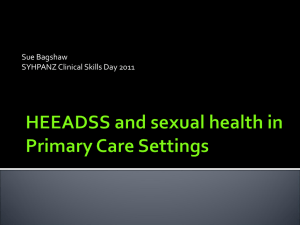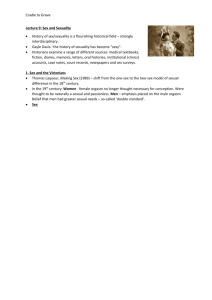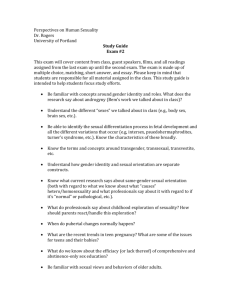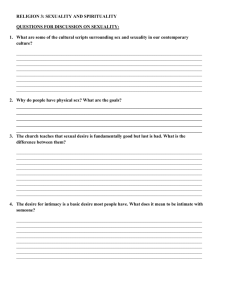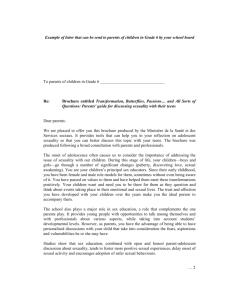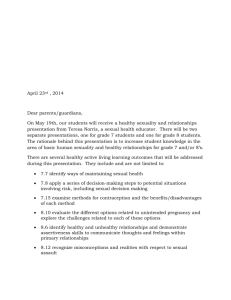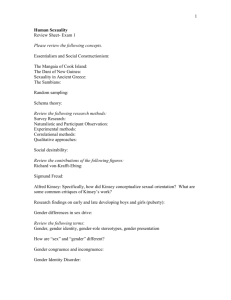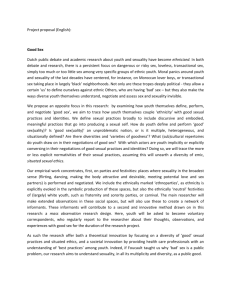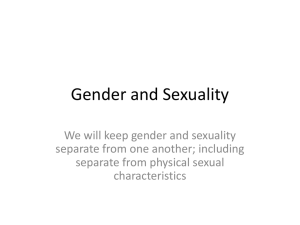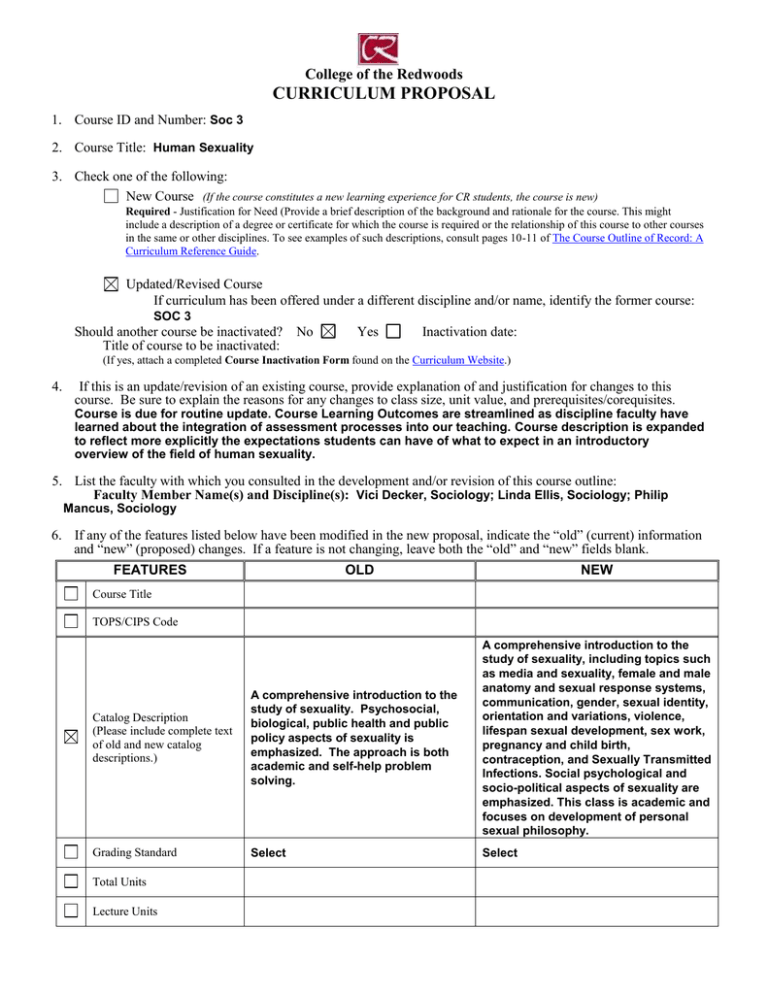
College of the Redwoods
CURRICULUM PROPOSAL
1. Course ID and Number: Soc 3
2. Course Title: Human Sexuality
3. Check one of the following:
New Course (If the course constitutes a new learning experience for CR students, the course is new)
Required - Justification for Need (Provide a brief description of the background and rationale for the course. This might
include a description of a degree or certificate for which the course is required or the relationship of this course to other courses
in the same or other disciplines. To see examples of such descriptions, consult pages 10-11 of The Course Outline of Record: A
Curriculum Reference Guide.
Updated/Revised Course
If curriculum has been offered under a different discipline and/or name, identify the former course:
SOC 3
Should another course be inactivated?
Title of course to be inactivated:
No
Yes
Inactivation date:
(If yes, attach a completed Course Inactivation Form found on the Curriculum Website.)
4.
If this is an update/revision of an existing course, provide explanation of and justification for changes to this
course. Be sure to explain the reasons for any changes to class size, unit value, and prerequisites/corequisites.
Course is due for routine update. Course Learning Outcomes are streamlined as discipline faculty have
learned about the integration of assessment processes into our teaching. Course description is expanded
to reflect more explicitly the expectations students can have of what to expect in an introductory
overview of the field of human sexuality.
5. List the faculty with which you consulted in the development and/or revision of this course outline:
Faculty Member Name(s) and Discipline(s): Vici Decker, Sociology; Linda Ellis, Sociology; Philip
Mancus, Sociology
6. If any of the features listed below have been modified in the new proposal, indicate the “old” (current) information
and “new” (proposed) changes. If a feature is not changing, leave both the “old” and “new” fields blank.
FEATURES
OLD
NEW
Course Title
TOPS/CIPS Code
Catalog Description
(Please include complete text
of old and new catalog
descriptions.)
A comprehensive introduction to the
study of sexuality. Psychosocial,
biological, public health and public
policy aspects of sexuality is
emphasized. The approach is both
academic and self-help problem
solving.
A comprehensive introduction to the
study of sexuality, including topics such
as media and sexuality, female and male
anatomy and sexual response systems,
communication, gender, sexual identity,
orientation and variations, violence,
lifespan sexual development, sex work,
pregnancy and child birth,
contraception, and Sexually Transmitted
Infections. Social psychological and
socio-political aspects of sexuality are
emphasized. This class is academic and
focuses on development of personal
sexual philosophy.
Grading Standard
Select
Select
Total Units
Lecture Units
Lab Units
Prerequisites
Corequisites
Recommended Preparation
Maximum Class Size
Repeatability—
Maximum Enrollments
Select
Select
Other
1. DATE: 11-25-12
2. DIVISION: Arts, Languages, and Social Sciences
3. COURSE ID AND NUMBER: Soc 3
4. COURSE TITLE: Human Sexuality
(Course title appears in Catalog and schedule of classes.)
5. SHORT TITLE: Human Sexuality
(Short title appears on student transcripts and is limited to 30 characters, including spaces.)
6. LOCAL ID (TOPS): 2208.00 Taxonomy of Program Codes
7. NATIONAL ID (CIP): 45.1101 Classification of Instructional Program Codes
8. DISCIPLINE(S): Sociology Select from Minimum Qualifications for Faculty
Course may fit more than one discipline; identify all that apply:
9. FIRST TERM NEW OR REVISED COURSE MAY BE OFFERED: Fall 2013
10. COURSE UNITS:
TOTAL UNITS:
LECTURE UNITS:
3.0
3.0
TOTAL HOURS: 54
LECTURE HOURS:
54
(1 Unit Lecture = 18 Hours; 1 Unit Lab = 54 Hours)
LAB UNITS:
LAB HOURS:
0
0
11. MAXIMUM CLASS SIZE: 40
12. WILL THIS COURSE HAVE AN INSTRUCTIONAL MATERIALS FEE? No
Yes
Fee: $
If yes, attach a completed Instructional Materials Fee Request Form found on the Curriculum Website.
GRADING STANDARD
Letter Grade Only
Pass/No Pass Only
Is this course a repeatable lab course? No
Yes
Grade-Pass/No Pass Option
If yes, how many total enrollments? Select
Is this course to be offered as part of the Honors Program? No
Yes
If yes, explain how honors sections of the course are different from standard sections. Students taking this course for
honor's credit are required to read additional course material, maintain regular contact with the
instructor for tutorial sessions, and either write a substantially more academically rigorous essay than
might otherwise be assigned in the class or complete an additional research project. Specific details of
these requirements are to be determined by the instructor, with preference given for enrolling honors
students in sections of this class which are taught by full time subject area faculty.
CATALOG DESCRIPTION -- The catalog description should clearly describe for students the scope of the course, its level, and what
kinds of student goals the course is designed to fulfill. The catalog description should begin with a sentence fragment.
A comprehensive introduction to the study of sexuality, including topics such as media and sexuality,
female and male anatomy and sexual response systems, communication, gender, sexual identity,
orientation and variations, violence, lifespan sexual development, sex work, pregnancy and child birth,
contraception, and Sexually Transmitted Infections. Social psychological and socio-political aspects of
sexuality are emphasized. This class is academic and focuses on development of personal sexual
philosophy.
Special Notes or Advisories (e.g. Field Trips Required, Prior Admission to Special Program Required, etc.):
PREREQUISITE COURSE(S)
No
Yes
Course(s):
Rationale for Prerequisite:
Describe representative skills without which the student would be highly unlikely to succeed .
COREQUISITE COURSE(S)
No
Yes
Course(s):
Rationale for Corequisite:
RECOMMENDED PREPARATION
No
Yes
Course(s): ENGL 150 or equivalent
Rationale for Recommended Preparation: Students need to be able to read and write at a college entry level in
order to successfully complete this course.
COURSE LEARNING OUTCOMES –This section answers the question “what will students be able to do as a result of
taking this course?” State some of the objectives in terms of specific, measurable student actions (e.g. discuss, identify,
describe, analyze, construct, compare, compose, display, report, select, etc.). For a more complete list of outcome verbs please
see Public Folders>Curriculum>Help Folder>SLO Language Chart. Each outcome should be numbered.
1. Employ a sociological perspective to explain the relationship between culture and sexuality.
2. Relate personal sexual philosophy to statements about sexual choice, behavior, love, violence,
sexual politics, or social policy.
3. Identify relationships between major course concepts.
COURSE CONTENT–This section describes what the course is “about”-i.e. what it covers and what knowledge students will acquire
Concepts: What terms and ideas will students need to understand and be conversant with as they demonstrate course
outcomes? Each concept should be numbered.
1. Social Policy.
2. Sexuality.
3. STI.
4. STI transmission.
5. Gender.
6. Sex.
7. Culture.
8. Sexual Philosophy.
9. Sexual Politics.
10. Sociological Perspective.
11. Sexual Anatomy.
12. Sexual Reproduction.
13. Contraception.
14. Birth Control.
15. Abortion.
16. Sexual Scripts.
17. Safer Sex Strategies.
18. Gender Roles.
19. Sexual Identity.
20. Sexual Variations.
21. Sexual Philosophy.
22.
Issues: What primary tensions or problems inherent in the subject matter of the course will students engage? Each issue
should be numbered.
1. Nature versus Nurture.
2. Interaction Between Social, Individual, and Physical Factors in Sexuality.
3. Use of Binary, Continuum, and Expanded Continuum Logic in Framing Perspectives Regarding
Topics Associated with Sexuality.
Themes: What motifs, if any, are threaded throughout the course? Each theme should be numbered.
1. The Effects of Time and Culture on How Sexuality is Defined, Experienced, Expressed, and Socially
Normalized.
2. The Relationship Between Values and Personal Sexual Philosophy.
3. Sexual Diversity.
Skills: What abilities must students have in order to demonstrate course outcomes? (E.g. write clearly, use a scientific
calculator, read college-level texts, create a field notebook, safely use power tools, etc). Each skill should be numbered.
1. Read, analyze, and critically evaluate text and data.
2. Write response essays.
3. Create and manage an independent study plan to effectively utilize time outside of class for learning
and reinforcing course content.
4. Engage in individual learning activities.
5. Clearly articulate a personal sexual philosophy.
6. Communicate complex ideas verbally to others in understandable ways.
7. Participate actively in group discussion, brainstorming, and decision-making processes.
REPRESENTATIVE LEARNING ACTIVITIES –This section provides examples of things students may do to engage the
course content (e.g., listening to lectures, participating in discussions and/or group activities, attending a field trip). These
activities should relate directly to the Course Learning Outcomes. Each activity should be numbered.
1.
2.
3.
4.
5.
6.
Reading text, essays, websites, or research articles outside of class.
Listening to lectures.
Reviewing and analyzing videos or other media.
Reflective journal writing activities.
Individual structured reflection activities.
Small and large group format discussion participation.
ASSESSMENT TASKS –This section describes assessments instructors may use to allow students opportunities to provide
evidence of achieving the Course Learning Outcomes. Each assessment should be numbered.
Representative Assessment Tasks (These are examples of assessments instructors could use.):
1. Objective or Subjective question based exams or quizzes.
2. Essays or reports.
3. Portfolio creation.
4. Book, article, or film summaries or reviews.
5. Project presentations.
Required Assessments for All Sections (These are assessments that are required of all instructors of all sections at all
campuses/sites. Not all courses will have required assessments. Do not list here assessments that are listed as representative assessments
above.):
1. Class midterm.
2. Class final.
3. Essay.
EXAMPLES OF APPROPRIATE TEXTS OR OTHER READINGS –This section lists example texts, not required texts.
Author, Title, and Date Fields are required
Author Yarber Title
Author Stombler
Human Sexuality: Diversity in Contemporary Society
et. al.
Title
Author Kimmel
and Plante
Author Rathus
et. al.
Title
Date
Sex Matters: The Sexuality and Society Reader
Title
2011
Date
Sexualities: Identities, Behaviors, and Society
Human Sexuality in a World of Diversity
Date
2009
Date
2004
2011
Other Appropriate Readings: "Risky Lessons: Sex Education and Social Inequality" by Fields (2008); "The
State of Sex: Tourism, Sex, and Sin in the New American Heartland" by Brents, Jackson & Hausbeck
(2009); "Sex for Sale: Prostitution, Pornography and The Sex Industry" by Weitzer (2009); "Speaking of
Sexuality: Interdisciplinary Readings" edited by Moore et. al. (2009); "The Gender of Sexuality:
Exploring the Possibilities" by Schwartz et. al. (1998).
COURSE TYPES
1.
Is the course part of a Chancellor’s Office approved CR Associate Degree?
No
Yes
If yes, specify all program codes that apply. (Codes can be found in Outlook/Public Folders/All Public Folders/ Curriculum/Degree
and Certificate Programs/choose appropriate catalog year):
Required course for degree(s)
Restricted elective for degree (s) BEHAV.LA.AA.
Restricted electives are courses specifically listed (i.e. by name and number) as optional courses from which students
may choose to complete a specific number of units required for an approved degree.
2.
Is the course part of a Chancellor’s Office approved CR Certificate of Achievement?
No
Yes
If yes, specify all program codes that apply. ( Codes can be found in Outlook/Public Folders/All Public Folders/ Curriculum/Degree
and Certificate Programs/choose appropriate catalog year):
Required course for certificate(s)
Restricted elective for certificate(s)
Restricted electives are courses specifically listed (i.e. by name and number) as optional courses from which students may
choose to complete a specific number of units required for an approved certificate.
3.
Is the course Stand Alone?
No
Yes
(If “No” is checked for BOTH #1 & #2 above, the course is stand alone.)
4.
Basic Skills: NBS Not Basic Skills
5.
Work Experience: NWE Not Coop Work Experience
6.
Course eligible Career Technical Education funding (applies to vocational and tech-prep courses only): No
7.
Course eligible Economic Workforce Development funding : No
Yes
(If TOPS code has an asterisk it is indicative that the course is vocational.)
8.
Purpose: Y Credit Course Course Classification Status
9.
Accounting Method: W Weekly Census
Yes
10. Disability Status: N Not a Special Class
11. Course SAM Priority Code: E Not Occupational Definitions of SAM Priority Codes
COURSE TRANSFERABILITY
1.
Current Transferability Status: A Transferable to both UC and CSU
2.
Course Prior to Transfer Level: Y Not Applicable Definitions of Course Prior to Transfer Levels
CURRENT TRANSFERABILITY STATUS (Check at least one box below):
This course is currently transferable to:
Neither CSU nor UC
CSU as general elective credit
CSU as a specific course equivalent (see below)
If the course transfers as a specific course equivalent give course number(s)/ title(s) of one or more currently-active,
equivalent lower division courses from CSU.
1. CourseSoc 110, Campus SFSU
2. Course
, Campus
UC as general elective credit
UC as specific course equivalent
If the course transfers as a specific course equivalent give course number(s)/ title(s) of one or more currently-active,
equivalent lower division courses from UC.
1. Course
, Campus
2. Course
, Campus
PROPOSED CSU TRANSFERABILITY (Check at least one of the boxes below):
No Proposal
Remove as General Education
Propose as General Elective Credit
Propose as a Specific Course Equivalent (see below)
If specific course equivalent credit is proposed, give course number(s)/ title(s) of one or more currently-active,
equivalent lower division courses from CSU.
1. Course
, Campus
2. Course
, Campus
PROPOSED UC TRANSFERABILITY (Check one of the boxes below):
No Proposal
Remove as General Education
Propose as General Elective Credit OR Specific Course Equivalent (fill in information below)
If “General Elective Credit OR Specific Course Equivalent” box above is checked, give course number(s)/ title(s) of one
or more currently-active, equivalent lower division courses from UC.
1. Course
, Campus
2. Course
, Campus
CURRENTLY APPROVED GENERAL EDUCATION Check at least one box below):
Not currently approved
CR
CR GE Category: B: Social Science
CSU
CSU GE Category: E
IGETC
IGETC Category: 4J
PROPOSED CR GENERAL EDUCATION (Check at least one box below):
No Proposal
__x__ Approved as CR GE by Curriculum Committee: _01.25.13_
Remove as General Education
(DATE)
Review to maintain CR GE Status
____ Not Approved
New GE Proposal
CR GE Outcomes
GE learning outcomes in Effective Communication, Critical Thinking, and Global Awareness must be addressed in all general
education courses.
Effective Communications: Explain how the proposed GE course fulfills at least one of the CR GE outcomes in this
category. Soc 3 CLO #1 is "Employ a sociological perspective to explain the relationship between culture
and sexuality". To explain the relationship between culture and sexuality requires students to
communicate about complex cultural and intellectual ideas. The impact of culture on sexuality- and vice
versa- is complex, indeed. Articulating these complex relationships is done by students as they
generate, compose, revise and communicate their ideas clearly, either orally or in writing. This process
contributes both to the meeting of a course CLO as well as to the CR GE outcomes for communication.
Additionally, Soc 3 CLO #2, "Relate personal sexual philosophy to statements about sexual choice,
behavior, love, violence, sexual politics, or social policy", is also part of how students learn to
communicate complex cultural and intellectual ideas in Soc 3. The development and articulation of a
personal sexual philosophy is a cornerstone for this course, doing so requires communication. In the
course of working with this CLO, students may also be called upon to listen or read with comprehension,
as relating personal sexual philosophy to statements requires students to hear or understand what they
are being asked to apply their philosophy to.
Critical Thinking: Explain how the proposed GE course fulfills at least one of the CR GE outcomes in this category.
The development of a personal sexual philosophy rests upon the identification of personal and social
values, as sexual philosophy could not be any more closely linked to values. By making judgments based
on their personal values, students come to understand what ethical decisions they can, do, or might
make regarding their own sexual choices and behaviors. No one set of values is understood to be right or
wrong within this context, rather sexual values are understood to be highly personal and ranging in
diversity throughout any given culture or society.Additionally, collective social values are identified as
students come to see how their personal sexual philosophies fit into collective, normative, ideas about the
relationship between ethics and sex or sexuality.Soc 3 CLO #2, "Relate personal sexual philosophy to
statements about sexual choice, behavior, love, violence, sexual politics, or social policy", is closely
linked to the CR GE outcome which addresses students learning to make value judgments and ethical
decisions. Additionally, students need to be able to evaluate ideas presented in writing, media, speech or
artistic representations in order to receive ideas about behavior, love, violence, sexual politics, or social
policy to which they are then asked to relate their personal philosophies.
Global Awareness: Explain how the proposed GE course fulfills at least one of the CR GE outcomes in this category.
Soc 3 CLO #1 is to "Employ a sociological perspective to explain the relationship between culture and
sexuality". A sociological perspective necessarily involves historical context, as such a perspective
hinges upon an ability to understand how historical context influences current social situations. The
relationship between culture and sexuality is such that it defines what is or is not considered a sexual
issue in the first place. For example, here students might be asked to analyze how Victorian cultural
ideas about sexuality has influenced the differences in sexual scripts between men and women as known
to us in contemporary US culture. In taking a sociological perspective, one cannot adequately discuss
sexual differences between men and women today without also discussing the history of how sexuality
has been conceptualized and understood as different for men and women.
Additionally, to meet this same CLO, students necessarily learn to analyze issues from multiple
perspectives and to demonstrate their awareness of cultures in a diverse global community. For example,
a major theme of this course is sexual diversity. This means that what sex is, how it is expressed,
experienced and understood, comes to be understood by students as being different from culture to
culture. Culture influences sexuality; a student must discuss at least two different cultures to demonstrate
an understanding of this relationship..
GE Criteria for Breadth and Generality
GE courses should be broad and general in scope. Typically such courses are introductory-- not advanced or specialized—and
the content encompasses a broad spectrum of knowledge within a given field of study.
Explain how the proposed GE course fulfills GE criteria for breadth and generality. This course is an introduction to
Human Sexuality. It operates as a comprehensive overview which introduces students to the topics and
inquiries which they are likely to encounter in a variety of trajectories of sexuality studies, social science
majors, and applied social or health service sector occupational fields. Sexuality studies is unique in that it is
interdisciplinary even in how it came to be conceived into existance within the academy. Sexuality came to be
situated within the academy largely throughout the 1980's, a time at which interdisciplinary approaches to
learning and knowledge building- especially between and among the social science disciplines- was being
strongly advocated for by many scholars. To teach an introduction to sexuality necessarily means offerring a
breadth of overview for a multitude of seemingly unrelated topics. For example, here STI prevention is
addressed in the same class that the sex industry and communication are introduced. Intro to Human Sexuality
is essentially a templated course, one for which many Intro level textbooks- all which outline repeated topic
overviews- exist. Taking this Intro course prepares students either for advanced technical training as nurses or
medical professionals, or for advanced study of sexuality in the fields of sociology, social work, other social
science fields, or in sexuality studies itself.
CR GE Area Designation
Course Learning Outcomes and Course Content should provide evidence of appropriate GE Area Designation.
Additional rationale for GE Area Designation (optional):
Natural Science
Social Science
Humanities
Language and Rationality
Writing
Oral Communications
Analytical Thinking
PROPOSED CSU GENERAL EDUCATION BREADTH (CSU GE) (Check at least one box below):
No proposal
A. Communications and Critical Thinking
A1 – Oral Communication
A2 – Written Communication
A3 – Critical Thinking
B. Science and Math
B1 – Physical Science
B2 – Life Science
B3 – Laboratory Activity
B4 – Mathematics/Quantitative Reasoning
C. Arts, Literature, Philosophy, and Foreign Language
C1 – Arts (Art, Dance, Music, Theater)
C2 – Humanities (Literature, Philosophy, Foreign
Language)
E. Lifelong Understanding and Self-Development
E1 – Lifelong Understanding
E2 – Self-Development
D. Social, Political, and Economic Institutions
D0 – Sociology and Criminology
D1 – Anthropology and Archeology
D2 – Economics
D3 – Ethnic Studies
D5 – Geography
D6 – History
D7 – Interdisciplinary Social or Behavioral Science
D8 – Political Science, Government and Legal Institutions
D9 – Psychology
Rationale for inclusion in this General Education category: Same as above
Proposed Intersegmental General Education Transfer Curriculum (IGETC) (Check at least one box below):
No proposal
1A – English Composition
1B – Critical Thinking-English Composition
1C – Oral Communication (CSU requirement only)
2A – Math
3A – Arts
3B – Humanities
4A – Anthropology and Archaeology
4B – Economics
4E – Geography
4F – History
4G – Interdisciplinary, Social & Behavioral Sciences
4H – Political Science, Government & Legal Institutions
4I – Psychology
4J – Sociology & Criminology
5A – Physical Science
5B – Biological Science
6A – Languages Other Than English
Rationale for inclusion in this General Education category:
Same as Above
Submitted By: Dana Maher
Division Chair/Director: Rachel Anderson
Approved by Curriculum Committee: No
Academic Senate Approval Date: 02.01.13
Tel. Ext.
4539
Review Date: 12/5/12
Date: 11/28/12
CURRICULUM COMMITTEE USE ONLY
Yes
Date: 01.25.13
Board of Trustees Approval Date: 03.05.13

